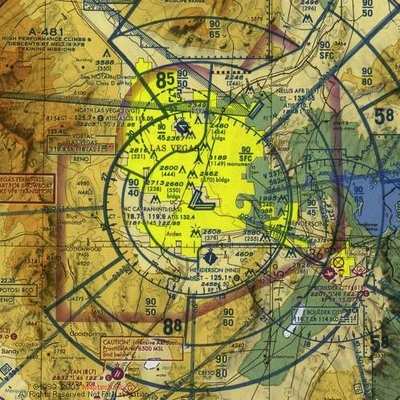Descending Aircraft Comes Within Three Miles Of Bizjet At
FL280
Was it truly a "close call"... and why did it happen? The
National Air Traffic Controllers Association told ANN Friday of an
incident in the skies over Nevada Thursday, in which an aircraft
descending through 28,000 feet came within 2.6 miles of a second
plane on converging flight paths.

Both aircraft were being vectored for spacing into McCarran
International Airport in Las Vegas just after 1300 local time
Thursday, during an especially busy time for the airport, according
to the controllers union. The two planes -- a Citation
750 and a LearJet 60 -- were under the control of the Los Angeles
Air Route Traffic Control Center.
NATCA says the planes would have come even closer... had the
pilots not responded to TCAS warnings, and a controller had not
vectored the planes away from each other.
The union tells ANN the situation is "an unfortunate example of
what happens in an overstressed, overworked, understaffed
situation, which happens routinely."
"This is another example of the Federal Aviation Administration
trying to do too much with too little," said Los Angeles Center
NATCA Facility Representative Garth Koleszar. "A controller
returning to the work area had to take action on his own to assist
the controller who was yelling for help. Unfortunately, he was too
late and the traffic complexity had already reached extreme levels.
The controller jumping in to help didn’t even have time to
receive a briefing on the sector traffic situations prior to the
error. The FAA supervisor had left the work area moments before and
had neglected to provide the controller with the needed help.
"This controller was left to work at above the sector volume at
extremely complex levels by himself," he said. “Anytime there
is sequencing due to high airport traffic demand, a
controller’s work load goes up exponentially.”
Aero-News has reported
extensively on the contentious state of affairs
between NATCA and the FAA, particularly since contract talks broke
down between the two sides last year. The FAA imposed its own
contract in June 2006, after the agency declared talks to be at an
impasse.
With that in mind, is this incident an ominous sign of looming
problems... or an attempt by NATCA to attract further attention to
its cause? It probably isn't surprising Ian Gregor, Western Region
spokesman for the FAA, leans towards the latter.
"This controller error had absolutely nothing to do with
staffing," Gregor tells ANN. "Indeed, the facts prove otherwise.
The sector in which the error occurred was fully staffed, there was
a routine number of aircraft in the sector when the controller made
the mistake, and a supervisor was present.
"The simple truth is that even good controllers occasionally
make mistakes," he added. "When they do, we have multiple layers of
safety in place to protect the traveling public."

Gregor also takes issue with NATCA's claims of short staffing at
control centers nationwide.
"We're fully aware that most of the current national controller
workforce will retire within the next decade, and we're
aggressively hiring new controllers to replace them," he said.
"Currently, we have about 14,800 controllers nationwide, compared
to about 14,600 a year ago. We met our hiring goal by bringing on
board more than 1,700 new controllers during Fiscal Year 2007
(which ended Sept. 30), and we're having no trouble recruiting
people for the positions."
NATCA's Koleszar asserts controllers have been forced to work
increased traffic volumes, with fewer associates to lend a hand.
"This is when mistakes happen," he said. "Sadly, controllers are
leaving the FAA at an increasing rate because of the FAA’s
treatment of its employees. It will get worse before it gets
better."
 ANN's Daily Aero-Linx (04.16.24)
ANN's Daily Aero-Linx (04.16.24) Aero-News: Quote of the Day (04.16.24)
Aero-News: Quote of the Day (04.16.24) Airborne 04.10.24: SnF24!, A50 Heritage Reveal, HeliCycle!, Montaer MC-01
Airborne 04.10.24: SnF24!, A50 Heritage Reveal, HeliCycle!, Montaer MC-01 Airborne 04.12.24: SnF24!, G100UL Is Here, Holy Micro, Plane Tags
Airborne 04.12.24: SnF24!, G100UL Is Here, Holy Micro, Plane Tags Airborne-Flight Training 04.17.24: Feds Need Controllers, Spirit Delay, Redbird
Airborne-Flight Training 04.17.24: Feds Need Controllers, Spirit Delay, Redbird




